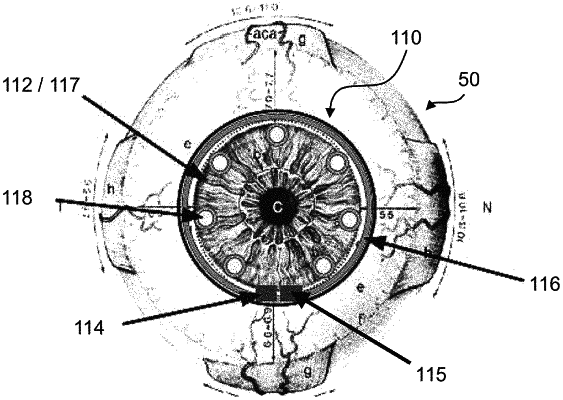| CPC A61F 9/0017 (2013.01) [A61B 3/16 (2013.01); A61B 5/4839 (2013.01); A61B 5/4857 (2013.01); A61B 5/6821 (2013.01); A61B 5/7267 (2013.01); G02C 11/10 (2013.01); G16H 20/10 (2018.01); G16H 50/50 (2018.01)] | 19 Claims |

|
1. An eye-mountable device, comprising:
a flexible substrate having an eye-mounting surface configured to be positioned on an eye of a patient;
a resonant impedance sensor comprising an annular, flexible inductor loop concentric with a circumference of the flexible substrate and operable to obtain a measurement related to a condition of the eye of the patient at a time based on a change in the annular flexible inductor loop, wherein the resonant impedance sensor is coupled to the flexible substrate;
a therapeutic agent delivery assembly coupled to the flexible substrate; and
a processor for executing a temporal model of a therapeutic agent delivery in communication with the sensor and the therapeutic agent delivery assembly, wherein the temporal model comprises a target measurement of the condition of the eye, wherein the processor is configured to:
receive the measurement related to the condition of the eye at the time from the resonant impedance sensor,
determine a measurement of the condition of the eye at the time based on a relationship between the measurement related to the condition of the eye at one time and the measurement of the condition of the eye at another time;
compare the measurement of the condition of the eye at the time to the target measurement of the condition;
determine an amount of a therapeutic agent to release from the therapeutic agent delivery assembly to the eye based on a difference between the measurement of the condition of the eye and the target measurement of the condition of the eye and the temporal model;
and
activate the therapeutic agent delivery assembly to administer the amount of the therapeutic agent to the eye of the patient.
|
|
11. A method for delivering a therapeutic agent to an eye of a patient, comprising:
receiving, by a processor coupled to an eye-mountable sensor, measurements related to a condition of the eye of the patient over a period of time from the eye-mountable sensor, wherein the eye mountable sensor comprises a flexible substrate and a resonant loop sensor having an annular, flexible inductor loop concentric with a circumference of the flexible substrate and having a diameter that changes based on the condition of the eye, wherein the measurements related to the condition of the eye are based on the diameter of the annular, flexible inductor loop;
establishing, by the processor, a temporal model for achieving a target measurement of the condition of the eye based on physiological characteristics of the patient, the patient's circadian rhythm, and the measurements related to the condition of the eye over the period of time;
receiving, by the processor, a measurement related to the condition of the eye at a time from the eye-mountable sensor;
determining, by the processor, a measurement of the condition of the eye at the time based on relationship between the measurement related to the condition of the eye at one time and the measurement of the condition of the eye at another time;
comparing, by the processor, the measurement of the condition of the eye at the time to a target measurement of the condition;
determining, by the processor, an amount of a therapeutic agent to release to the eye based on a difference between the measurement of the condition of the eye and the target measurement of the condition of the eye and the temporal model;
activating, by the processor, delivery of the amount of the therapeutic agent to the eye of the patent from a therapeutic agent delivery assembly coupled to the eye-mountable sensor; and
modifying, by the processor, the temporal model based on the measurement of the condition of the eye at the time and measurements of the condition of the eye determined after the therapeutic agent is delivered.
|
|
15. An eye-mountable device, comprising:
an intraocular pressure (IOP) sensor coupled to a contact lens, the IOP sensor comprising a resonant circuit comprising an annular, flexible inductor loop concentric with a circumference of the contact lens and having a diameter configured to change in response to a change in an IOP of the eye of the patient wearing the contact lens, wherein the change in the diameter of the annular, flexible inductor loop results in a change in the resonance of the resonant circuit, wherein the resonance change is reflective of the change in the IOP;
at least one reservoir coupled to the contact lens and comprising a therapeutic agent and a film positioned over an opening in the reservoir to seal the therapeutic agent within the reservoir; and
a processor coupled to the contact lens and in communication with the IOP sensor and the at least one reservoir, wherein the processor comprises a temporal model configured to achieve a target IOP of the eye and is configured to:
receive the resonance of the resonant circuit of the IOP sensor at a time;
determine the IOP of the eye at the time based on the resonance of the resonant circuit of the IOP sensor at the time;
determine an amount of the therapeutic agent to release to the eye based on a comparison of the IOP of the eye at the time and the target IOP of the eye; and
activate at least one of the at least one reservoir to release the amount of the therapeutic agent to the eye of the patient by applying a voltage to the film of the at least one reservoir,
wherein the temporal model comprises time-dependent instructions for releasing the therapeutic agent to the eye of the patient, and wherein the processor activates the reservoir according to the temporal model.
|